Fiber optics is a pure glass that long and thin and the diameter of human hair. And in its use several optical fiber rolled into one in a place called optical cables and used to deliver digital data in the form of light in a great distance.
Parts of the fiber optic
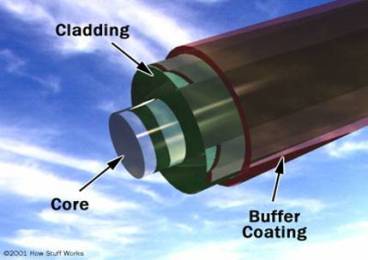
Core is a thin glass which is a core part of the fiber optic beam delivery where performed.
Cladding is the material surrounding the nucleus that function reflects the light back into the nucleus (core).
Buffer Coating is a plastic coating that protects the fiber from damage.
Type of Fiber Optics
1. Single-mode fibers
Having a small core (diameter of 0.00035 inches or 9 microns) and serves to send infrared laser beam (wavelength 1300
-1550 nanometer)
2. Multi-mode fibers
Having a larger core (diameter of 62.5 microns or 0.0025 inch) and the function transmit infrared laser light (wavelength of 850-1300 nanometers)

How Fiber Optics Work
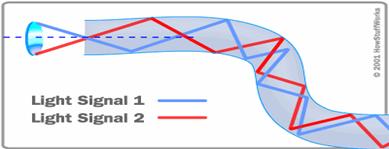
Ray in an optical fiber runs through the core to be bouncing off the cladding, and this is called total internal reflection, because the cladding does not absorb light at all from the core. However, due to impurities glass light signal will be degraded, depending on the purity of the signal resistance of the glass and the wavelength of the signal.
Fiber Optic Advantages
Cheap: when compared with copper wire in the same length.
Thinner; have a smaller diameter than copper cable.
Greater capacity.
Signal degradation is smaller.
Not flammable: Not an electric discharge.
Flexible.
Digital signal.
How Fiber Optics Created
Making a preform glass cylinder
This process is called modified chemical vapor deposition (MCVD).
Silicon and germanium react with oxygen to form SiO2 and GeO2.
SiO2 and GeO2 converge and form the glass.
This process is done automatically and takes several hours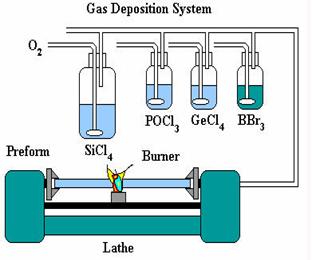
Drawing the fiber from the preform
After the first process is finished preform is inserted into a fiber drawing tower.
Then heated 1900-2200 degrees Celsius until melted.
Melt it down past the laser micrometer so that the preform to form yarn.
Conducted coating and UV curing process.
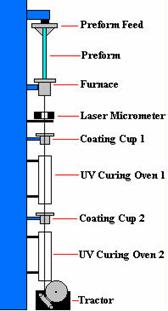
Testing the Finished Optical Fiber
Tensile strength: to be able to withstand lb/inch2 100,000 or more.
Refractive index profile: calculating the screen to optical reflection.
Fiber geometry: Core diameter, cladding dimensions, cloating diameter is uniform.
Attenuation: calculate the signal strength of various wavelengths and distances.
Information carrying capacity: bandwidth
Chromatic dispersion: the spread of various wavelengths of light through the core.
Operating temperature
Frequently Used Optical Cable
Distribution Cable
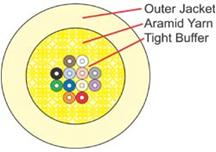
Indoor/Outdoor Tight Buffer

Indoor/Outdoor Breakout Cable

Aerial Cable/Self-Supporting
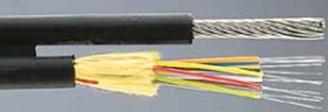
Hybrid & Composite Cable

Armored Cable
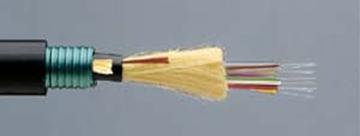
Low Smoke Zero Halogen (LSZH)
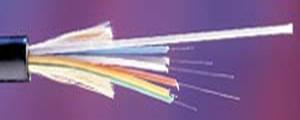
Parts of the fiber optic

Core is a thin glass which is a core part of the fiber optic beam delivery where performed.
Cladding is the material surrounding the nucleus that function reflects the light back into the nucleus (core).
Buffer Coating is a plastic coating that protects the fiber from damage.
Type of Fiber Optics
1. Single-mode fibers
Having a small core (diameter of 0.00035 inches or 9 microns) and serves to send infrared laser beam (wavelength 1300
-1550 nanometer)

2. Multi-mode fibers
Having a larger core (diameter of 62.5 microns or 0.0025 inch) and the function transmit infrared laser light (wavelength of 850-1300 nanometers)

How Fiber Optics Work

Ray in an optical fiber runs through the core to be bouncing off the cladding, and this is called total internal reflection, because the cladding does not absorb light at all from the core. However, due to impurities glass light signal will be degraded, depending on the purity of the signal resistance of the glass and the wavelength of the signal.
Fiber Optic Advantages
Cheap: when compared with copper wire in the same length.
Thinner; have a smaller diameter than copper cable.
Greater capacity.
Signal degradation is smaller.
Not flammable: Not an electric discharge.
Flexible.
Digital signal.
How Fiber Optics Created
Making a preform glass cylinder
This process is called modified chemical vapor deposition (MCVD).
Silicon and germanium react with oxygen to form SiO2 and GeO2.
SiO2 and GeO2 converge and form the glass.
This process is done automatically and takes several hours

Drawing the fiber from the preform
After the first process is finished preform is inserted into a fiber drawing tower.
Then heated 1900-2200 degrees Celsius until melted.
Melt it down past the laser micrometer so that the preform to form yarn.
Conducted coating and UV curing process.

Testing the Finished Optical Fiber
Tensile strength: to be able to withstand lb/inch2 100,000 or more.
Refractive index profile: calculating the screen to optical reflection.
Fiber geometry: Core diameter, cladding dimensions, cloating diameter is uniform.
Attenuation: calculate the signal strength of various wavelengths and distances.
Information carrying capacity: bandwidth
Chromatic dispersion: the spread of various wavelengths of light through the core.
Operating temperature
Frequently Used Optical Cable
Distribution Cable

Indoor/Outdoor Tight Buffer

Indoor/Outdoor Breakout Cable

Aerial Cable/Self-Supporting

Hybrid & Composite Cable

Armored Cable

Low Smoke Zero Halogen (LSZH)
